- Clone
- 259D (See other available formats)
- Regulatory Status
- RUO
- Other Names
- Forkhead box protein P3, Scurfin, JM2, IPEX, Zinc finger protein JM2
- Ave. Rating
- Submit a Review
- Product Citations
- publications

-

Human peripheral blood lymphocytes were stained with True-Nuclear™ Human Treg Flow™ Kit (FOXP3 Alexa Fluor® 488/CD4 PE-Cy5/CD25 PE). -

| Cat # | Size | Price | Quantity Check Availability | Save | ||
|---|---|---|---|---|---|---|
| 320403 | 25 tests | 423€ | ||||
FOXP3 is a 50-55 kD transcription factor, also known as Forkhead box protein P3, Scurfin, JM2, or IPEX. It is proposed to be a master regulatory gene and more specific marker of T regulatory cells than most cell surface markers (such as CD4 and CD25). Transduced expression of FOXP3 in CD4+/CD25- cells has been shown to induce GITR, CD103, and CTLA4 and impart a T regulatory cell phenotype. FOXP3 is mutated in X-linked autoimmunity-allergic dysregulation syndrome (XLAAD or IPEX) in humans and in "scurfy" mice. Overexpression of FOXP3 has been shown to lead to a hypoactive immune state suggesting that this transcriptional factor is a central regulator of T cell activity. In human, unlike in mouse, two isoforms of FOXP3 have been reported: one (FOXP3) corresponding to the canonical full-length sequence; the other (FOXP3 δ2) lacking exon 2. The 259D antibody recognizes human FOXP3 epitope in the region of amino acids 105-235.
Product DetailsProduct Details
- Verified Reactivity
- Human
- Reported Reactivity
- Cynomolgus, Rhesus, Baboon, Chimpanzee
- Antibody Type
- Monoclonal
- Immunogen
- Full-length FOXP3 protein
- Concentration
- Lot-specific (to obtain lot-specific concentration and expiration, please enter the lot number in our Certificate of Analysis online tool.)
- Storage & Handling
- This kit is guaranteed for six months. Upon receipt, store between 2°C and 8°C, and protected from prolonged exposure to light. Do not freeze.
- Application
-
ICFC - Quality tested
- Application Notes
-
Materials Provided:
1. Alexa Fluor® 488 anti-human FOXP3 - 25 tests
2. Alexa Fluor® 488 Mouse IgG1, κ isotype control - 25 tests
3. True-Nuclear™ Transcription Factor Buffer Set - 120 tests (Cat. No. 424401)
4. anti-human CD4 PE-Cy5/CD25 PE Cocktail - 50 tests
Materials Not Included:
1. Cell Staining Buffer (Cat. No. 420201)
2. Single color compensation controls
Immunofluorescence Staining Procedures:
1. Perform cell surface staining as described in BioLegend's Cell Surface Immunofluorescence Staining Protocol. Add 20 µL of the anti-human CD4 PE-Cy5/CD25 PE cocktail to each tube and incubate in the dark for 20 minutes.
2. Add 2 mL of the cell staining buffer, centrifuge tubes at 400 x g at room temperature for five minutes, and discard the supernatant.
3. Repeat Step 2, for a total of two washes.
4. Add 1 mL of the Transcription Factor 1X Fix solution to each tube, vortex, and incubate at room temperature in the dark for 45-60 minutes.
5. Without washing, add 2 mL of the Transcription Factor 1X Perm Buffer to each tube.
6. Centrifuge tubes at 400 x g at room temperature for five minutes, and discard the supernatant.
7. Add 2 mL of the Transcription Factor 1X Perm Buffer to each tube.
8. Centrifuge tubes at 400 x g at room temperature for five minutes, and discard the supernatant.
9. Resuspend the cell pellet in 100 µL of the Transcription Factor 1XPerm Buffer.
10. Add 5 µL of Alexa Fluor® 488 anti-human FOXP3 antibody or 5 µL of Alexa Fluor® 488 mouse IgG1, κ isotype control into the appropriate tubes. Incubate in the dark at room temperature for at least 30 minutes.
11. Add 2 mL of the Transcription Factor 1X Perm Buffer to each tube.
12. Centrifuge tubes at 400 x g at room temperature for five minutes, and discard the supernatant.
13. Add 2 mL of the cell staining buffer.
14. Centrifuge tubes at 400 x g at room temperature for five minutes, and discard the supernatant.
15. Resuspend in 0.5 mL cell staining buffer and then acquire tubes on a flow cytometer.
Caution: The True-Nuclear™ Transcription Factor Buffer Set contains paraformaldehyde, which is toxic and mutagenic. Please handle with caution. Wear gloves, lab coats, and necessary protection to avoid direct contact.
NOTE: For flow cytometric staining with this clone, True-Nuclear™ Transcription Factor Buffer Set (Cat. No. 424401) offers improved staining and is highly recommended. -
Application References
(PubMed link indicates BioLegend citation) -
- Roncador G, et al. 2005 Eur. J. Immunol. 35:1681.
- Yang ZZ, et al. 2006. Blood 107:3639. PubMed
- Gavin MA, et al. 2006. P. Natl. Acad. Sci. USA 103:6659. PubMed
- Groh V, et al. 2006. Nature Immunology 7:755. PubMed
- Tran DQ, et al. 2007. Blood doi:10.1182/blood-2007-06-094656.PubMEd
- Long SA, et al. 2008. J Autoimmun. 30:293. PubMed
- Gong G, et al. 2009. Blood 113:837. PubMed
- Long SA, et al. 2009. Eur J. Immunol. 39:612. PubMed
- Long SA, et al. 2010. Diabetes. 59:407. PubMed
- Ferraro A, et al. 2014. PNAS. 111:1111. PubMed
- Vudattu NK, et al. 2014. J Immunol. 193:587. PubMed
- Dupont G, et al. 2014. Cytokine. 69:146. PubMed
Antigen Details
- Structure
- Forkhead/winged-helix transcription factor family, approximately 50 kD, contains zinc finger and forkhead domains
- Distribution
-
Nuclear; expressed in T regulatory cells
- Function
- Transcription factor proposed to be a master regulatory gene in T regulatory cell development and a critical factor for immune homeostasis
- Interaction
- Interacts with DNA
- Cell Type
- Tregs
- Biology Area
- Cell Biology, Immunology, Transcription Factors
- Molecular Family
- CD Molecules, Nuclear Markers
- Antigen References
-
1. Hori S, et al. 2003. Science 299:1057.
- Regulation
- FOXP3 is present at high levels in T regulatory cell can also be induced by T cell activation
- Gene ID
- 50943 View all products for this Gene ID
- UniProt
- View information about FOXP3 on UniProt.org
Related FAQs
- What type of PE do you use in your conjugates?
- We use R-PE in our conjugates.
- Can I stain whole blood with anti-FOXP3 using your Foxp3 staining kit?
-
It is not recommended. It is best to use PBMCs for this testing.
- Can FOXP3 be costained with cytokines?
-
The larger holes created by the nuclear permeabilization required for FOXP3 may allow cytokines to leak out of the cell, making it harder to detect lowly-expressed cytokines. You may have to use a control where the cells are only permeabilized through the cell membrane.
Other Formats
View All FOXP3 Reagents Request Custom Conjugation| Description | Clone | Applications |
|---|---|---|
| PE anti-human FOXP3 | 259D | ICFC |
| Purified anti-human FOXP3 | 259D | WB,IHC-P,ICFC,SB |
| Alexa Fluor® 488 anti-human FOXP3 | 259D | ICFC |
| Alexa Fluor® 647 anti-human FOXP3 | 259D | ICFC |
| Pacific Blue™ anti-human FOXP3 | 259D | ICFC |
| True-Nuclear™ Human Treg Flow™ Kit (FOXP3 Alexa Fluor® 488/CD4 PE-Cy5/CD25 PE) | 259D | ICFC |
Customers Also Purchased
Compare Data Across All Formats
This data display is provided for general comparisons between formats.
Your actual data may vary due to variations in samples, target cells, instruments and their settings, staining conditions, and other factors.
If you need assistance with selecting the best format contact our expert technical support team.
-
PE anti-human FOXP3

Human peripheral blood lymphocytes were surface stained with... 
-
Purified anti-human FOXP3
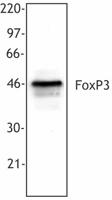
Cell extract from HEK293T cells transfected with human FoxP3... 
Formalin-fixed, paraffin-embedded Cynomolgus kidney was trea... 
SeqIF™ (sequential immunofluorescence) staining on COMET™ of... -
Alexa Fluor® 488 anti-human FOXP3
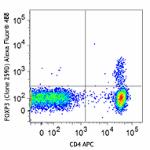
Human peripheral blood lymphocytes were surface stained with... 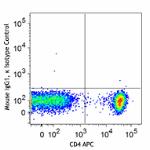
-
Alexa Fluor® 647 anti-human FOXP3
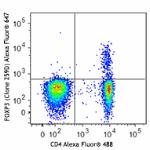
Human peripheral blood lymphocytes were surface stained with... 
-
Pacific Blue™ anti-human FOXP3

Human peripheral blood lymphocytes were surface stained with... 
-
True-Nuclear™ Human Treg Flow™ Kit (FOXP3 Alexa Fluor® 488/CD4 PE-Cy5/CD25 PE)
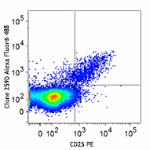
Human peripheral blood lymphocytes were stained with True-Nu... 
 Login / Register
Login / Register 









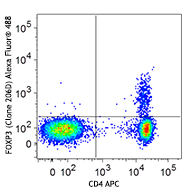
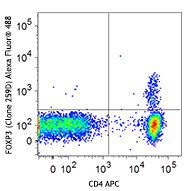
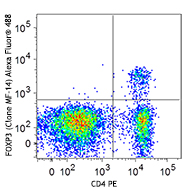
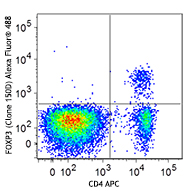



Follow Us